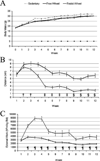Progressive resistance voluntary wheel running in the mdx mouse
- PMID: 21104862
- PMCID: PMC3392646
- DOI: 10.1002/mus.21764
Progressive resistance voluntary wheel running in the mdx mouse
Abstract
Exercise training has been minimally explored as a therapy to mitigate the loss of muscle strength for individuals with Duchenne muscular dystrophy (DMD). Voluntary wheel running is known to elicit beneficial adaptations in the mdx mouse model for DMD. The aim of this study was to examine progressive resistance wheel running in mdx mice by comprehensively testing muscle function before, during, and after a 12-week training period. Male mdx mice at ~4 weeks age were randomized into three groups: Sedentary, Free Wheel, and Resist Wheel. Muscle strength was assessed via in vivo dorsiflexion torque, grip strength, and whole body tension intermittently throughout the training period. Contractility of isolated soleus muscles was analyzed at the study's conclusion. Both Free and Resist Wheel mice had greater grip strength (~22%) and soleus muscle specific tetanic force (26%) compared with Sedentary mice. This study demonstrates that two modalities of voluntary exercise are beneficial to dystrophic muscle and may help establish parameters for an exercise prescription for DMD.
Figures






References
-
- Aitkens SG, McCrory MA, Kilmer DD, Bernauer EM. Moderate resistance exercise program: its effect in slowly progressive neuromuscular disease. Arch Phys Med Rehabil. 1993;74:711–715. - PubMed
-
- Lynch GS, Hinkle RT, Faulkner JA. Force and power output of diaphragm muscle strips from mdx and control mice after clenbuterol treatment. Neuromuscul Disord. 2001;11:192–196. - PubMed
-
- Sacco P, Jones DA, Dick JR, Vrbova G. Contractile properties and susceptibility to exercise-induced damage of normal and mdx mouse tibialis anterior muscle. Clin Sci (Lond) 1992;82:227–236. - PubMed
-
- Grange RW, Call JA. Recommendations to define exercise prescription for Duchenne muscular dystrophy. Exerc Sport Sci Rev. 2007;35:12–17. - PubMed
Publication types
MeSH terms
Grants and funding
LinkOut - more resources
Full Text Sources

